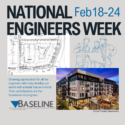By Noah Nemmers, PE
 Low-impact development (LID) is a term used to describe a land planning and engineering design approach to managing storm water runoff. LID emphasizes conservation and use of on-site natural features to protect water quality. This approach implements engineered small-scale hydrologic controls to replicate the pre-development hydrologic regime of watersheds through infiltrating, filtering, storing, evaporating, and detaining runoff close to its source.
Low-impact development (LID) is a term used to describe a land planning and engineering design approach to managing storm water runoff. LID emphasizes conservation and use of on-site natural features to protect water quality. This approach implements engineered small-scale hydrologic controls to replicate the pre-development hydrologic regime of watersheds through infiltrating, filtering, storing, evaporating, and detaining runoff close to its source.
Baseline has been involved in numerous stormwater management projects that utilize LID techniques over the last decade. Here are some of the things the company has learned and practical considerations to keep in mind when planning and implementing LID and disconnection strategies:
- Infiltration is cost-effective in porous soil but not an option when the soil is contaminated.
- Colorado’s high clay content and expansive soils often require amendment and underdrains to allow for LID techniques to be effective.
- For structures with basements, the outfall should occur far enough away from the building and proper drainage should be maintained away from all foundations.
- Installing new infiltration systems around existing basements should be avoided unless the walls are retrofitted with waterproofing.
- For buildings larger than two stories high, an underground roofdrain dispersion structure may be necessary because of the volume and speed of the runoff.
Strategies
- Promote infiltration at the surface by using engineered topsoil and be sure to select the right plantings for erosion control.
- Don’t undersize the rocks used for splash blocks or inlets, and make sure all users are OK with their appearance before using this method.
- Target a grade for bioswales between 0.5 and 1 percent; steeper bioswales will act as a ditch and suffer from erosion.
- Keep in mind that if you use wood mulch and your bioretention areas fill up with water, the chips can float away into parking lots and clog stormwater inlets.
- Infiltration zones should be built at the end of construction projects when the site is most stable and site runoff won’t clog these areas.
- Aboveground disconnection techniques will result in short-term ponded water, which some might view as an eyesore. Therefore, property owners, building users and the community need to be educated about the environmental benefits of these strategies and the role they play in protecting waterways.
For more information, please contact noah@baselinecorp.com.



